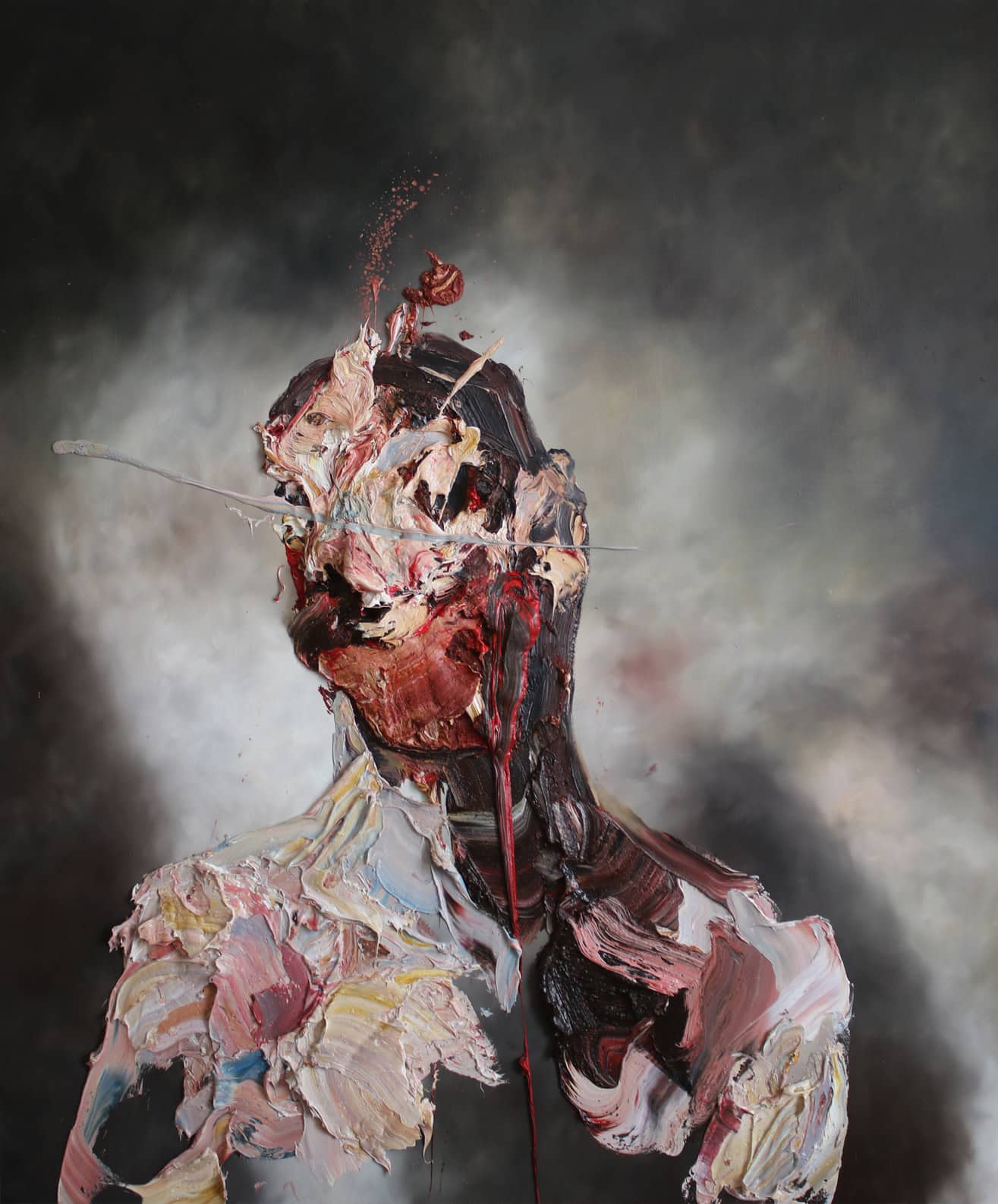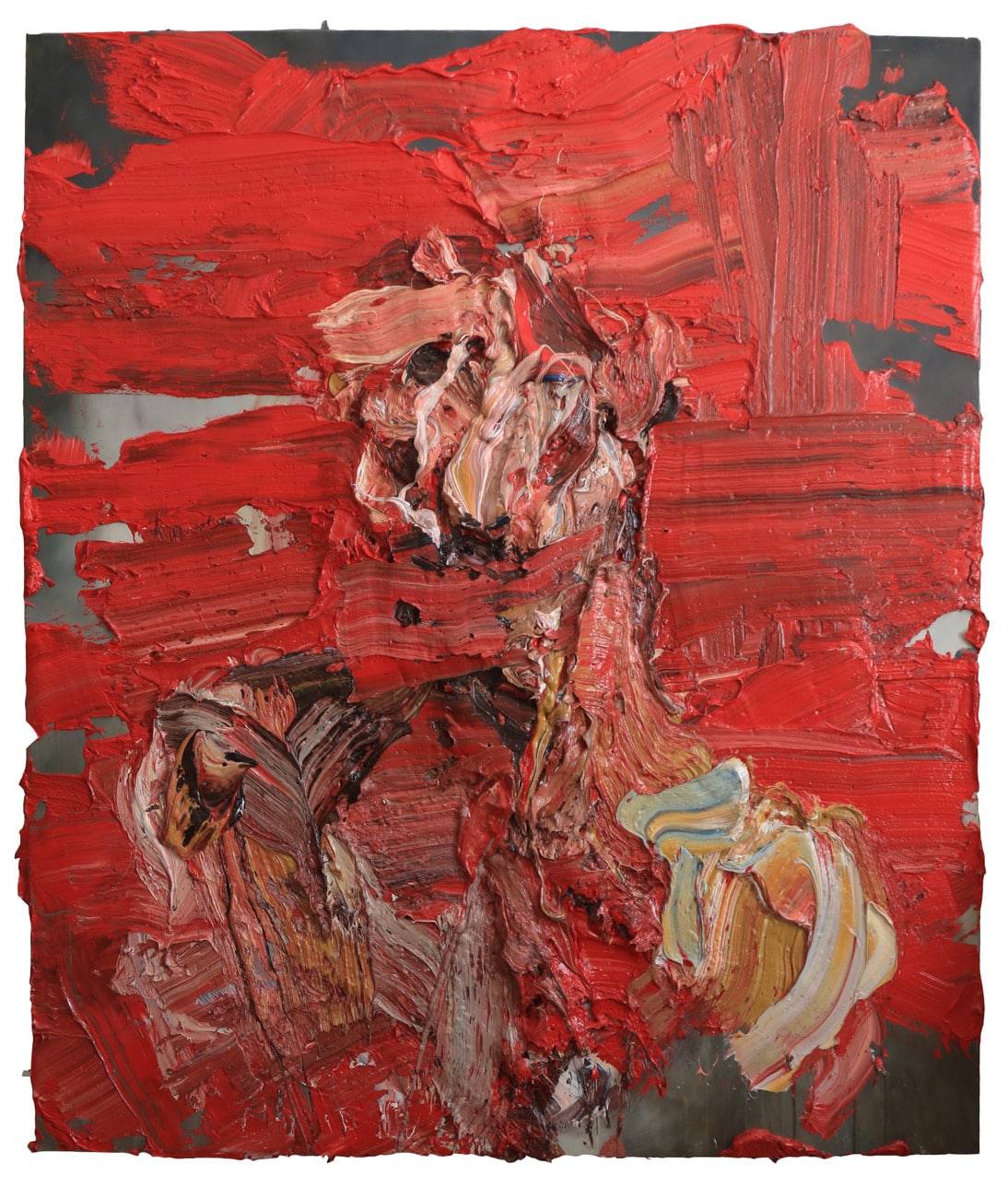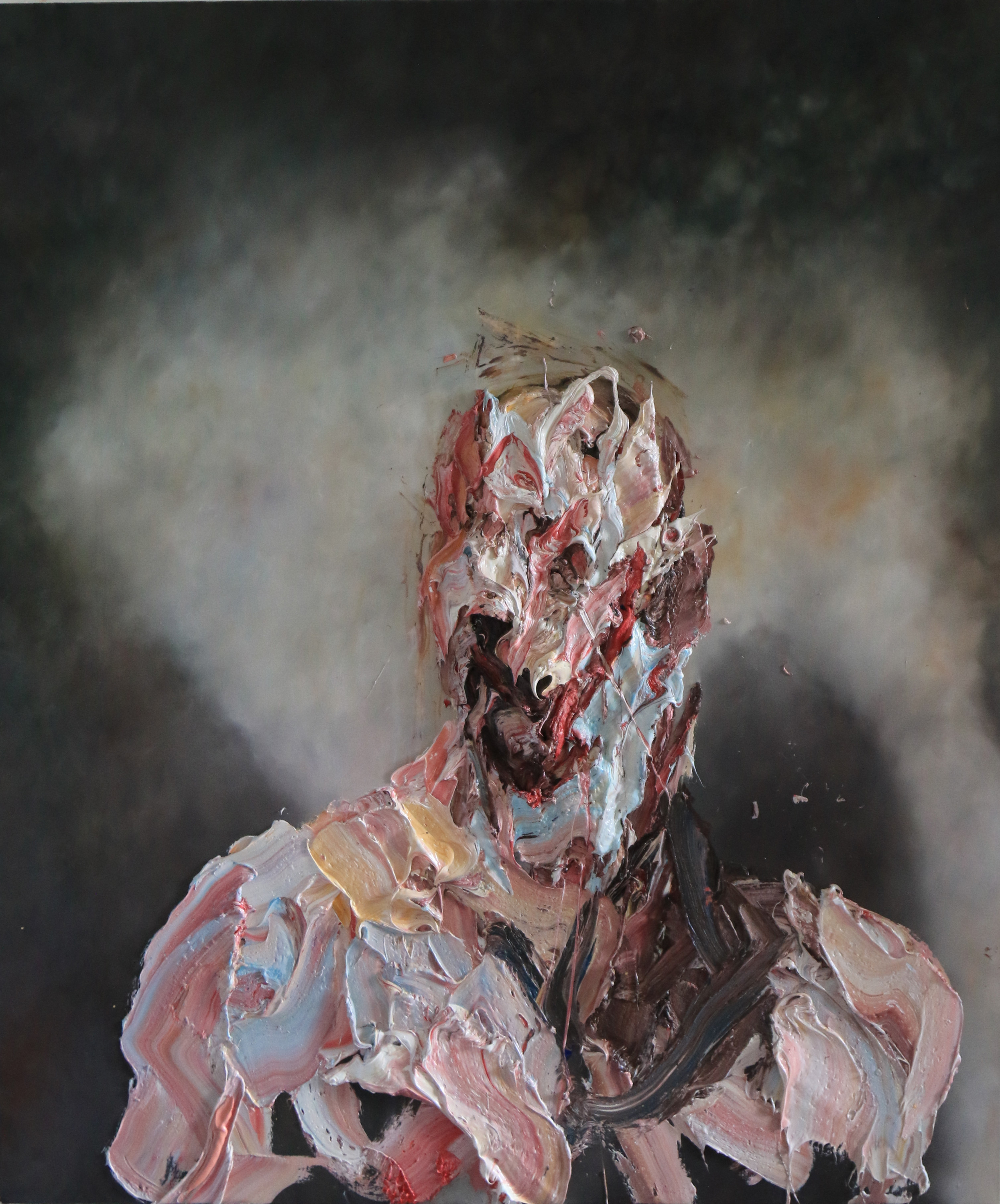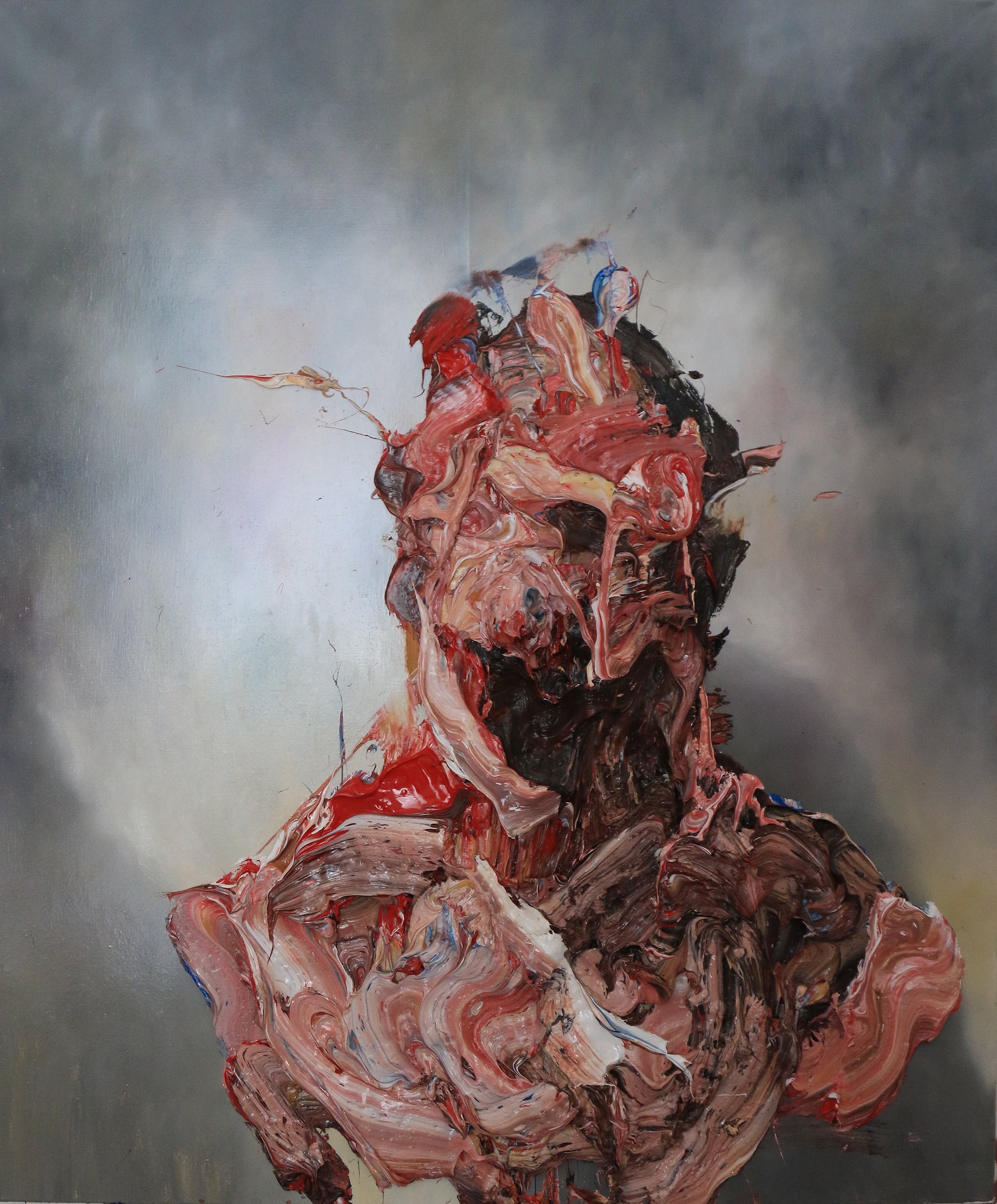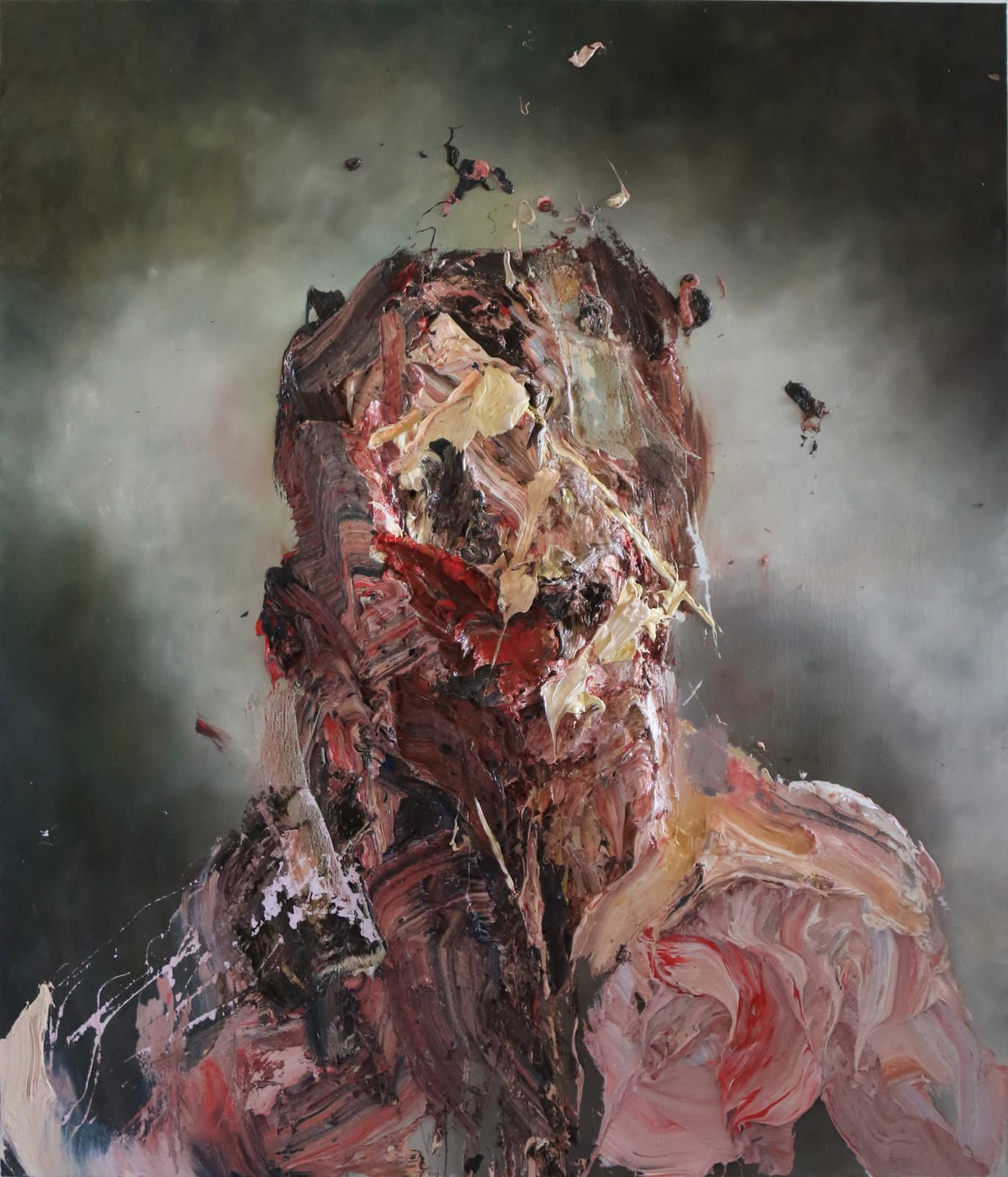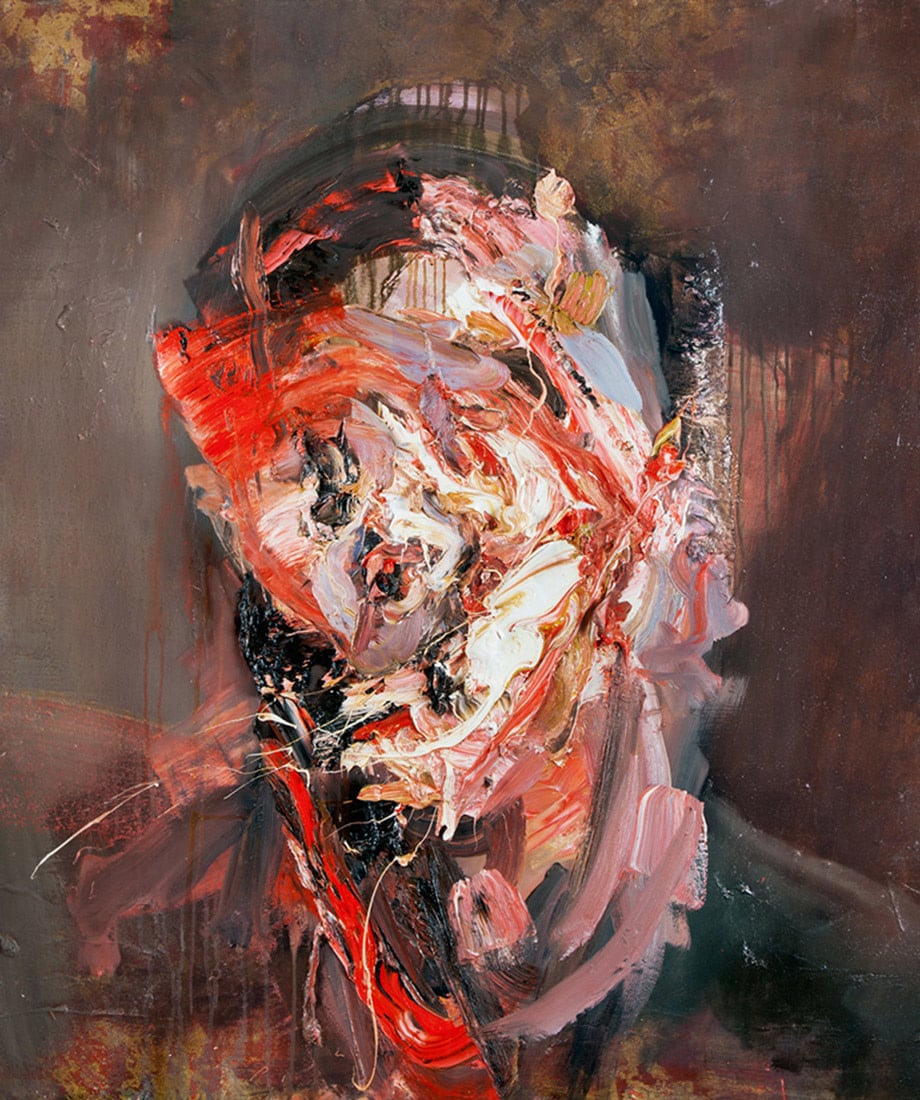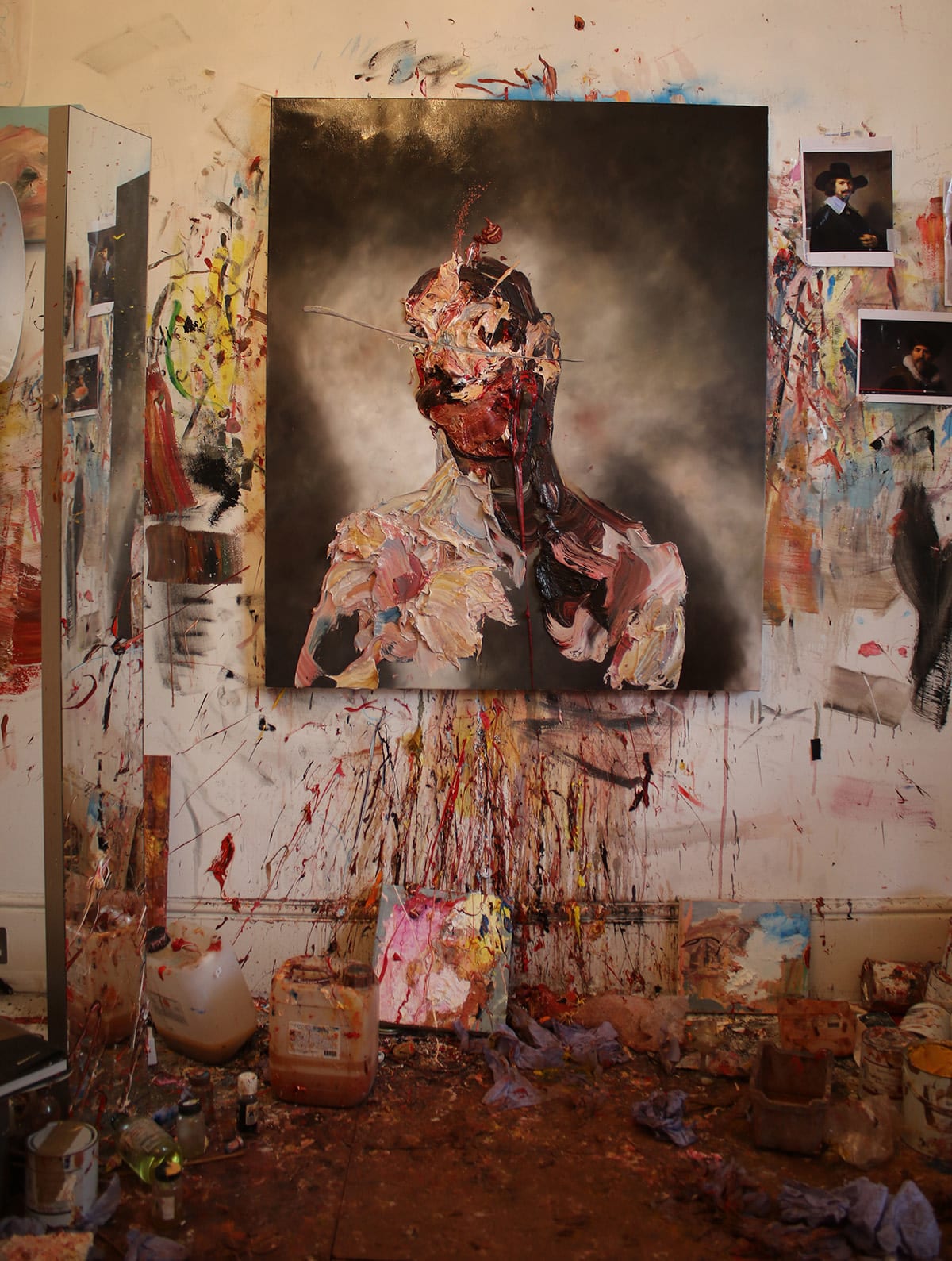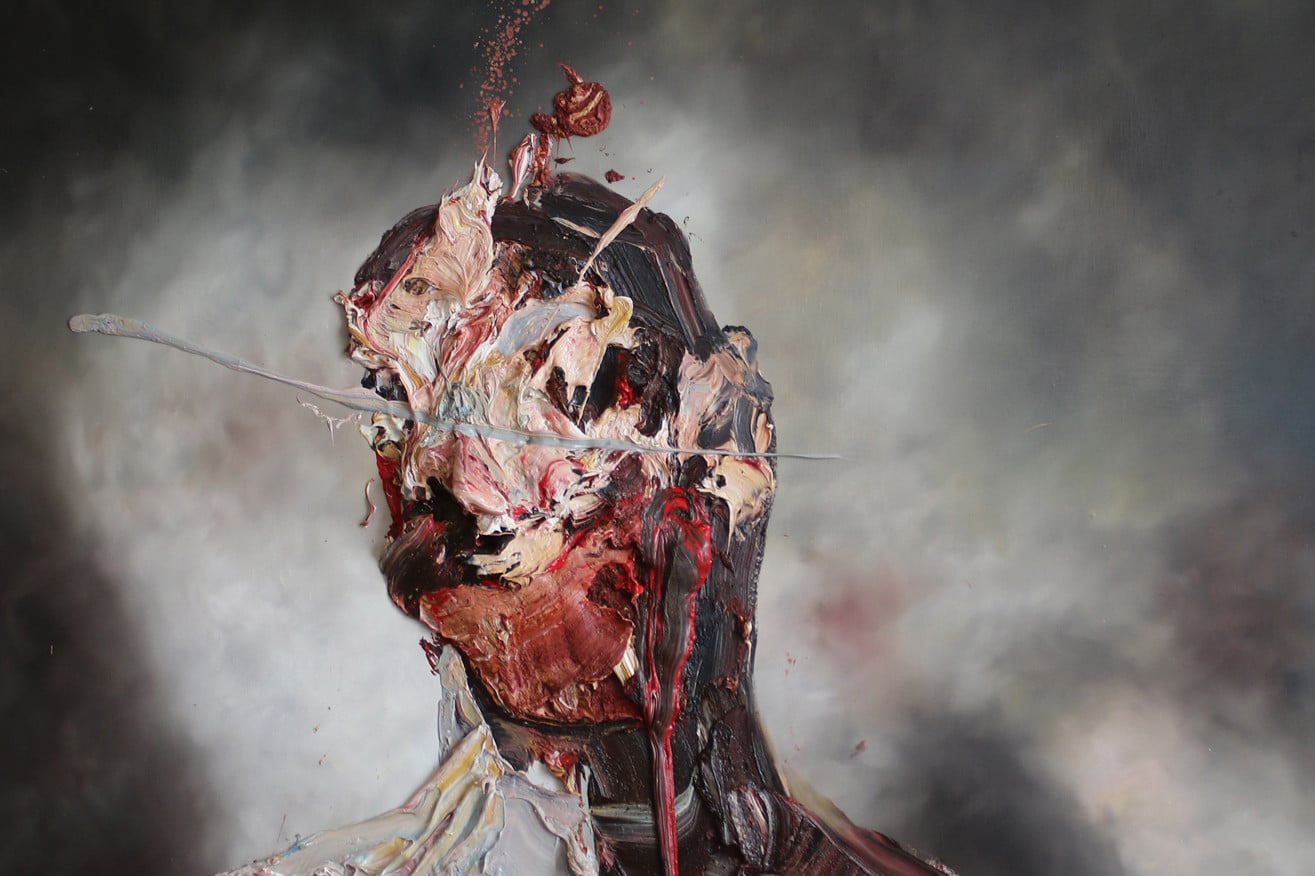In his latest body of work, Raw Intent, the British painter Antony Micallef has created a series of unsettling self portraits that feel both abstract and deeply personal. Working in a heavily textured style with echoes of Frank Auerbach and Francis Bacon, Micallef’s work is sometimes shocking, even grotesque, with massive brushstrokes giving his art an uncomfortably organic feel. Having studied under John Virtue, a former student of Auerbach, Micallef draws on expressionist techniques, but his work is decidedly contemporary.
Gaining recognition in 2000 when he was a runner-up in the BP Portrait Award competition, Micallef has since focused on themes such as consumerism and political injustice. In 2007, Micallef participated in Banksy’s Palestine exhibition Santa’s Ghetto, which aimed to raise awareness of extreme poverty in the West Bank. Recently, especially in Raw Intent, Micallef has focussed on more experimental, less representational work. “For every painting I do, I never know what I’m going to unearth,” he says. “I feel like my eyes are closed and I’m excavating, trying to bring this thing up to the surface.”
Micallef isn’t totally done with politically critical art, though—in the run up to the American election last fall, he created a work titled Trump’s Fags for an anti-Trump group exhibition in New York. The series, which was sold to benefit charity, featured the President’s face painted on cigarette packets, right above the health warnings. Micallef has used cigarette packs as canvases for a while; it’s a medium that characterizes the way his practice tends to combine high and low culture.
We had the chance to talk with the London-based artist about the chaotic work process behind his paint-splattered canvases, why he prefers to use himself as a subject, and what he thinks new media like VR means for the future of painting.
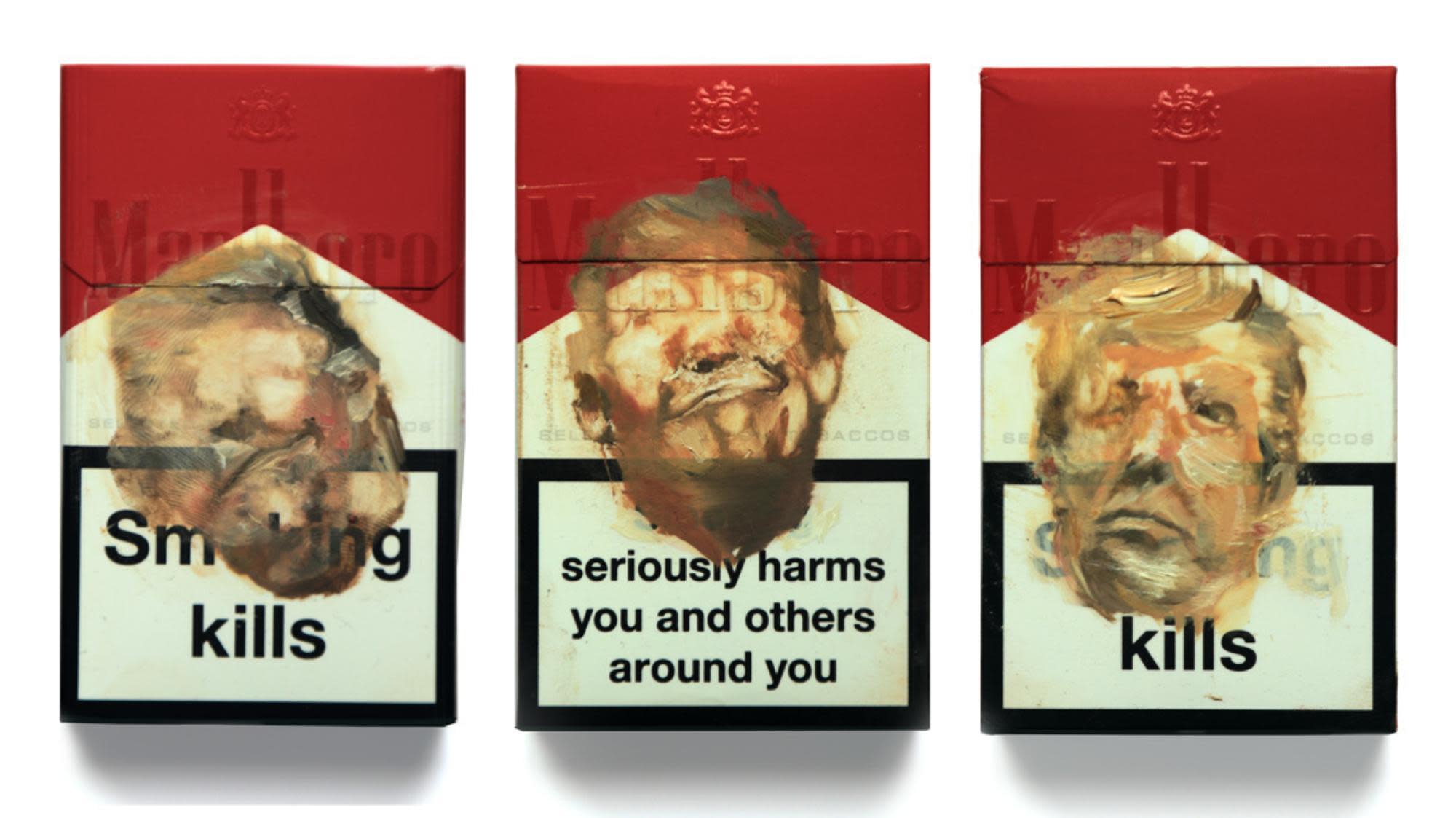
Format: One of the most startling things about your work is that while your portraits are definitely intense and violent at first viewing, they become increasingly introspective and even comforting as you continue to engage with them. Is this sort of catharsis something you aim for in your work?
Antony Micallef: It’s really interesting to hear that point of view. I think it’s all about using the medium. The actual process of painting the figures is quite chaotic, but also very immersive and meditative. Your entire body and your surroundings get covered with paint. The whole experience moves like a jigsaw puzzle that’s simultaneously melting, and every mark you make sets off another mark on the opposite side of the canvas. So it’s quite an organic process. That being said, making the portraits isn’t very relaxing. It’s only afterwards, when you step back and see what you’ve got, that you get those kind of reflective moments.
There’s also a prominent element of shock in your paintings. How do you think this impacts what you’re trying to achieve?
I want these paintings to be more than paintings—I want them to have a feeling that is really present, and to have a presence. I try to make my work command the room in that sense. It’s funny when you say shock, because that’s not something I intend to do. I think that type of impact is inevitable, because I’m literally throwing the paint with such power onto the canvas from about a metre and a half away, using very heavy, foot-long brushes. That probably translates into the shock you’re talking about. I want the figure in the portrait to be dynamic, to have contrast and stand out.
Why do you use yourself as a subject?
There are a couple of reasons. Number one, it’s quite a heavy setup to have a big canvas, surrounded by tins of paint and a big pallet on wheels. Second, I feel I can do whatever I want to myself; destroy my own face or whatever I’m making, without any apologies. It’s a very insular way of working, but it really suits me. I use myself as a model, but I don’t always see the portraits as me. I’m the vehicle for whatever seems to happen, I guess.
I obviously know myself very well, and I don’t think I’ve met anyone yet whom I could have as a sitter. I’m not sure if I’ve ever painted in front of other people in the way I’m working now. I’d like to, but I don’t know how it’ll work because it’s such a chaotic way of painting.
Your work makes observations about our media-focused society and a culture which is desensitized by the proliferation of images. How do you locate those subjects in yourself? Do you feel like you’re a representation of what’s going on around you?
What you’ve just mentioned is more to do with my earlier work. At that time, I would say I was always guilty of the things I painted about. I’m completely part of that consumer culture. This body of work I’m making now is really about being human. It’s funny, my parents would say to me, “Why don’t you paint landscapes or a picture of Jesus?” I’d go and paint the darkest thing I could think of. I’ve always thought that I can’t compete with God when it comes to landscapes, but I know what it is to be human. I find my current work is not really about making that kind of observation about society. It’s about trying to convey emotion in some way, and if it’s doing that then I’m winning.
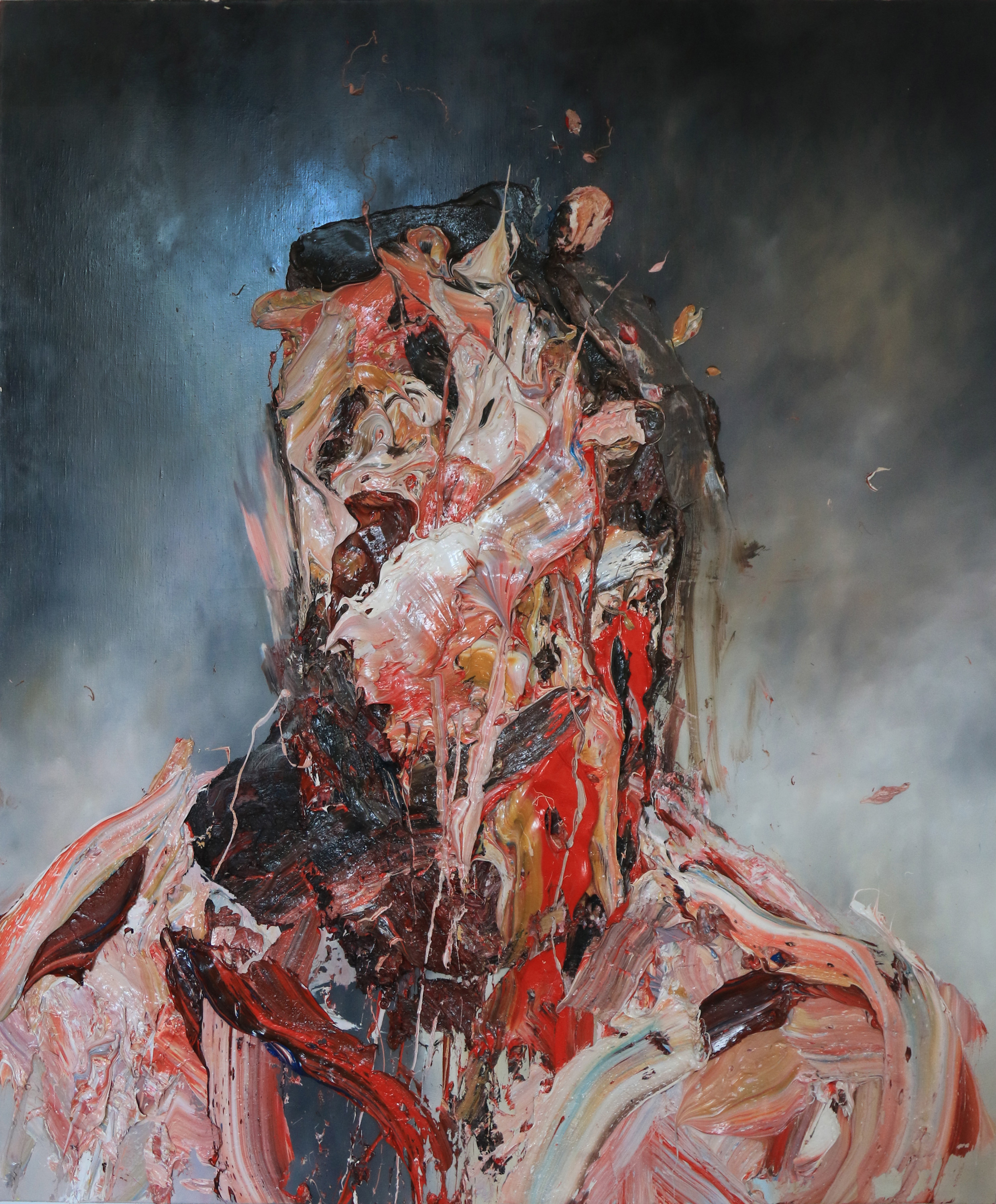
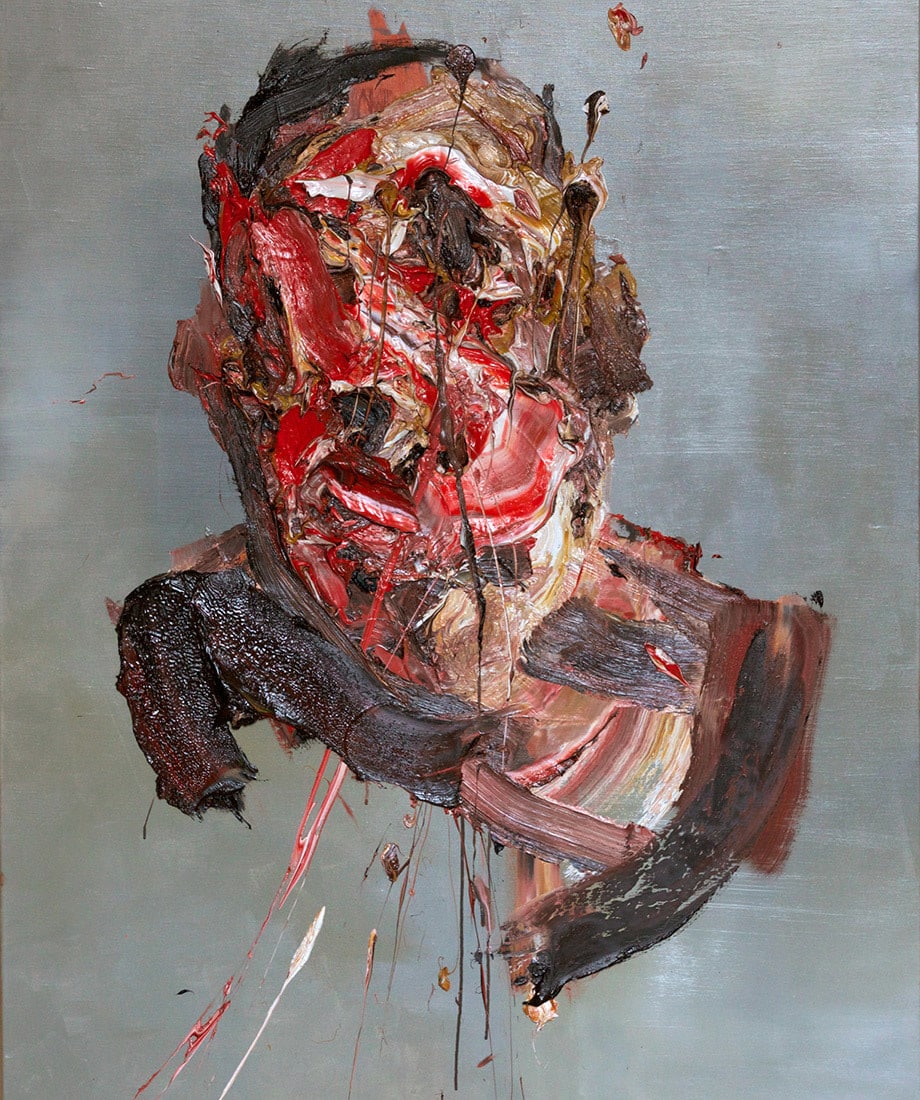
You use a lot of the same colors to paint the actual figures in your portraits, most notably red, and then your background colors range a lot. Why do you use colors in this way?
It’s funny, someone asked me the same question the other day about red. I never see it as blood—I always see it as the color red. It’s such a vibrant color. I don’t want something that whispers, I want something that shouts. Red is like a screaming child. You’ve really got to learn how to control it, and I enjoy that challenge.
Do you begin painting a piece with a particular idea in mind, or do you intuit what you want to create while you paint?
I’m constantly having ideas. I’ll be walking down the road, sitting in the bath, watching adverts before a movie, and ideas just kind of fall into my head like slides. I get so excited sometimes and think, ‘I want to paint this, I want to do that, I’ve got to try and write this down before I forget.’ I’m always very excited by ideas—I just don’t have enough hands to paint them all. I’m completely disorganized as a person. I wish I could be a little bit more organized, but in some ways that’s how my art is made.
In the end, I’ll arrive at my studio with ten ideas, approach the canvas, and then it’s all about having a dialogue. Sometimes the canvas and the paint want to take the piece in a completely different direction, and it can be a real surprise. Over time you learn that you’ve got to meet each other in the middle and see what happens. It’s through being in the studio and working that ideas generally blossom or turn into something new, and it’s through the practice of making that the really good things happen.
How did it go in the studio today?
It was okay, not a great day. I didn’t do too bad, but I’m not over the moon. You can’t win them all. I’m going to meet a friend later because I don’t want to be painting all day. Sometimes, when you’re leaving the studio and the piece in front of you is shit, you go home in a really bad mood. I’m a very impatient painter, which is why my paintings look the way they do. Today, I left the studio thinking, ‘I can come in tomorrow and we can work on this.’
Why do you think painting is less important to most people today than in the past?
We live in a society with technological advances that allow us to make and preserve work in lots of different media. You’re always going to have fashions and trends—it was video in the ’80s, now it’s virtual reality. There are lots of figurative painters who are getting into VR, but it doesn’t really appeal to me. Well, it might be fun to have a try, but it’s not something I’d want to show because I think in ten years it will have been drawn into the mass of images that have already been created. At least if I make a painting it’s on a solid piece of canvas and I can hold it.
These are all just different ways of communicating, and no one is better than the other. It’s about how you use your language in whatever medium you choose. I don’t think painting will ever disappear. Ever since we’ve been able to mix colored bits of earth and put them on the wall of a cave or a canvas, painting has always been this fundamental staple that I think we’ll always come back to. It’s our oldest way of communicating. I imagine in the future on the Starship Enterprise there’ll be a Van Gogh, and it won’t be a replica or some kind of 3D model—hopefully they’ll have the real one.
